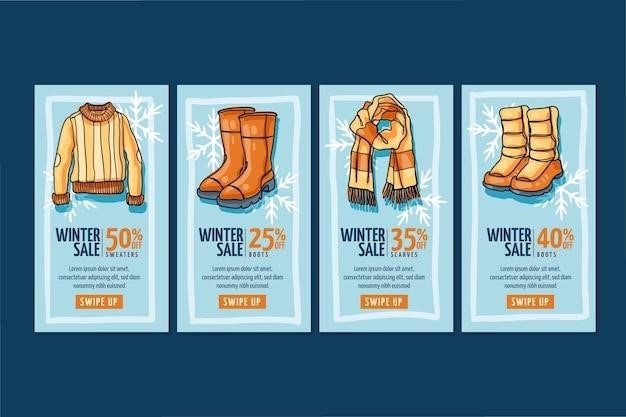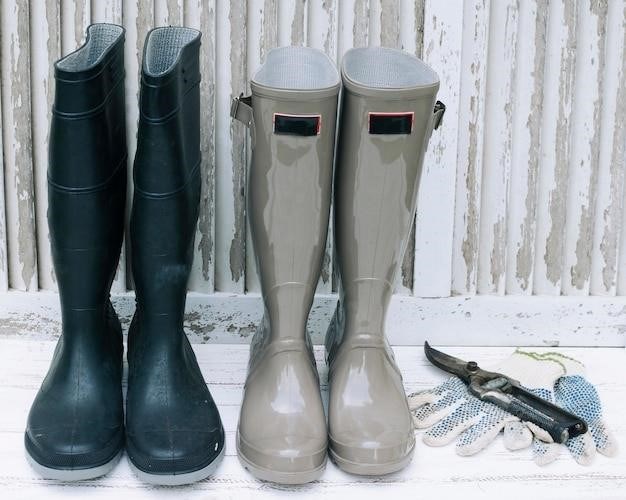Finding the perfect pair of boots involves understanding your foot size and width, exploring boot sizing systems, and considering factors that influence fit. This guide will provide you with the necessary information to ensure a comfortable and stylish boot experience.
Measuring Your Foot
Accurate foot measurement is crucial for finding the right boot size. Follow these steps for precise results⁚
- Wear a thin sock⁚ This simulates the thickness of a sock you’d wear with your boots.
- Place your heel against a wall⁚ Stand with your back flat against a wall, ensuring your heel touches the wall.
- Measure both feet⁚ Most people have one foot slightly larger than the other. Measure both feet and note the longer foot length;
- Measure from the longest toe to the heel⁚ Use a measuring tape to measure the distance from the tip of your longest toe to the back of your heel. Make sure the tape is perpendicular to your foot.
- Consider the time of day⁚ Your feet tend to be slightly larger at the end of the day due to swelling. Measure your feet at the end of the day for the most accurate results.
It’s essential to measure your feet carefully, as even slight differences can impact the fit of your boots. Remember to measure both feet and use the longer measurement to determine your boot size.
Understanding Boot Width
Boot width refers to the measurement across the ball of your foot, where it’s widest. It’s just as important as your length measurement for ensuring a comfortable fit. Boots typically come in various widths, often denoted by letters⁚
- B (Extra Narrow)⁚ Suits feet significantly narrower than average.
- C (Narrow)⁚ Fits feet slightly narrower than average.
- D (Regular)⁚ The most common width, suitable for standard foot widths.
- E (Wide)⁚ Designed for feet wider than average.
- EE (Extra Wide)⁚ Accommodates feet considerably wider than average.
- EEE (Triple Wide)⁚ Provides ample room for very wide feet;
Determining your boot width is crucial for a comfortable fit. If you have narrow feet, choosing a narrower width like B or C will prevent slipping and provide a secure feel. Conversely, if you have wide feet, opt for a wider width like E, EE, or EEE to avoid squeezing your toes and causing discomfort. Always refer to the specific boot size chart for the brand you’re interested in to find their width sizing guidelines.
Boot Size Charts
Boot size charts are essential tools for finding the right fit. They provide a visual representation of how boot sizes correspond to foot measurements. These charts typically display foot length in inches or centimeters and may also indicate the width of the boots.

When using a boot size chart, it’s crucial to locate the chart specific to the brand and style of boots you’re interested in; Boot sizes can vary significantly between brands, even if they use the same sizing system.
To use a boot size chart effectively, measure your foot length accurately, as outlined in the “Measuring Your Foot” section of this guide. Then, find the corresponding size on the chart. Some charts may also indicate the width of the boot, allowing you to select the appropriate width based on your foot measurements.
Always double-check the specific guidelines provided by the brand for interpreting their size chart. Some brands may offer additional information about their sizing, such as whether they recommend sizing up or down for certain styles or materials.
Finding Your Perfect Fit
Achieving the perfect fit in boots is crucial for comfort and style. While boot size charts provide a starting point, several factors can influence the fit, making it essential to consider these elements when selecting your boots.
First, consider the style of boot. Boots with a pointed toe or a narrow shaft may require a slightly larger size to accommodate the shape of your foot. Boots with a wider toe box or a looser shaft may allow for a more generous fit.
Next, take into account the material of the boot. Leather boots tend to stretch over time, so you may want to size down slightly. Synthetic materials are typically less forgiving, so it’s best to order your true size or even size up if you’re between sizes.
Finally, remember that boot fit can vary depending on the brand. Some brands may have a narrower fit than others, so it’s always helpful to consult the brand’s sizing guide and read customer reviews for guidance.
When trying on boots, pay close attention to how they feel. Make sure your toes have ample space to move freely, and the shaft should fit comfortably around your ankle and calf. If the boot feels too tight or too loose, consider adjusting the size or trying a different style or brand.
By understanding the nuances of boot sizing and considering these factors, you can find the perfect fit that allows you to enjoy your boots with comfort and style.
Tips for Measuring Your Foot
Accurate foot measurements are essential for finding the right boot size. To ensure precise measurements, follow these steps⁚
- Wear thin socks⁚ Measure your feet while wearing socks similar to what you would wear with your boots. Thick socks can add extra length, affecting your measurement.
- Measure both feet⁚ Feet can be different sizes, so measure both and use the larger measurement. You may need to order a size that fits your larger foot.
- Measure at the end of the day⁚ Your feet tend to swell slightly throughout the day, so measure them towards the end of the day for a more accurate measurement.
- Stand upright⁚ Place your heel against a wall and stand upright. This ensures that your foot is in a natural position.
- Use a measuring tape⁚ Place the measuring tape on the floor, perpendicular to the wall, and measure from the back of your heel to the tip of your longest toe.
- Note the measurement⁚ Record your foot measurement in centimeters or inches, depending on the size chart you are using.
By following these tips, you can obtain accurate foot measurements that will help you find the perfect boot size and enjoy a comfortable fit.
Factors Affecting Boot Fit
While foot size is a crucial aspect of boot fit, several other factors contribute to a comfortable and secure fit. Understanding these factors will help you make informed decisions when selecting your boots.
- Boot Style⁚ Different boot styles, such as ankle boots, knee-high boots, or cowboy boots, have varying fits. Some styles may have a more snug fit around the ankle, while others may have a wider calf opening.
- Materials⁚ Boot materials like leather, suede, or canvas can affect the overall fit. Leather tends to stretch over time, while suede and canvas may be more flexible.
- Insoles and Linings⁚ The presence of insoles or linings can also impact the fit. Thick insoles can add extra volume, while soft linings provide a more comfortable feel.
- Personal Preferences⁚ Individual preferences regarding fit and comfort play a significant role. Some people prefer a snug fit, while others prefer a bit more room.
- Activity Level⁚ The intended activity level can influence boot fit. Boots for hiking or walking require a more secure fit to provide support and stability.
By considering these factors in addition to your foot size, you can choose boots that fit comfortably and provide the desired level of support and flexibility for your intended use.
Understanding Boot Sizing Systems
Boot sizing systems can be a bit confusing, as different brands and countries may use different scales. It’s important to understand the various systems to ensure you select the right size. Here’s a breakdown of common boot sizing systems⁚
- US Sizing⁚ This system is widely used in the United States and Canada. It typically uses whole and half sizes, with a letter denoting the width (e.g., 8.5D).
- EU Sizing⁚ European sizing is based on centimeters and typically uses whole numbers. A size 40 in EU sizing is roughly equivalent to a size 8 in US sizing.
- UK Sizing⁚ The UK sizing system is similar to the US system but uses slightly different measurements. A UK size 7 is generally equivalent to a US size 8.
It’s essential to note that boot sizing can vary between brands. Always check the size chart provided by the specific manufacturer to ensure accurate sizing. In addition to the overall size, pay attention to width measurements, as this can significantly affect boot fit.
Converting Between Sizing Systems
When shopping for boots online or internationally, you’ll likely encounter different sizing systems. Understanding how to convert between these systems is crucial for selecting the correct size. While online conversion tools can be helpful, it’s important to use them as a guide and not rely solely on them. Many factors can influence sizing, including brand variations and individual foot shape.
Here’s a general guide to converting between common sizing systems⁚
- US to EU⁚ Subtract 32 from the US size (e.g., US 9 is EU 41).
- US to UK⁚ Subtract 0.5 from the US size (e.g., US 9 is UK 8.5).
- EU to US⁚ Add 32 to the EU size (e.g., EU 41 is US 9).
- UK to US⁚ Add 0.5 to the UK size (e.g., UK 8.5 is US 9).
Remember, these are just general conversions. It’s always best to consult a specific brand’s size chart for the most accurate information. If you’re unsure, consider contacting the retailer for assistance.
Choosing the Right Boot Style
The perfect boot style goes beyond just size and width; it’s about finding a silhouette that complements your individual needs and preferences. Different boot styles are designed for specific purposes and activities, impacting fit and comfort.
- Ankle Boots⁚ These versatile boots offer a sleek and stylish look, perfect for casual or dressier occasions. They typically have a lower shaft height, ending at the ankle, making them suitable for various leg shapes and heights.
- Knee-High Boots⁚ These boots extend to the knee, providing a more dramatic and fashion-forward look. They often feature a slimmer fit and can be paired with dresses, skirts, or jeans. Consider the shaft height and circumference to ensure a comfortable fit and flattering silhouette.
- Cowboy Boots⁚ These iconic boots are known for their distinctive pointed toe and high heel. They offer a unique and stylish option for both casual and formal events. Pay attention to the heel height and shaft circumference for a comfortable and stylish fit.
- Work Boots⁚ Designed for durability and safety, work boots feature sturdy construction and a reinforced toe. They are typically wider and provide ample support for heavy lifting and other demanding tasks. Choose a work boot with a size and width that allows for proper foot movement and stability.
Before making a decision, think about how you’ll wear the boots, the activities you’ll be doing, and the desired style. Consider trying on different styles to find the perfect fit and feel for your unique needs.
Resources for Boot Sizing
Navigating the world of boot sizing can be challenging, especially when dealing with different brands and sizing systems. Luckily, there are several resources available to assist you in finding the perfect fit.
- Brand Websites⁚ Most reputable boot brands provide detailed size charts and conversion guides on their websites. These charts often include specific measurements for each boot style and allow you to compare your foot measurements to their sizing recommendations.
- Online Shoe Stores⁚ Many online shoe retailers offer size guides and conversion charts for their entire boot inventory. These resources can help you determine the correct size and width for specific boots based on your foot measurements.
- Customer Reviews⁚ Reading customer reviews can provide valuable insights into the fit and sizing of specific boots. Look for comments mentioning fit, size accuracy, and potential sizing discrepancies.
- Boot Sizing Calculators⁚ Online boot sizing calculators are a convenient tool for converting between sizing systems and determining the correct boot size based on your foot measurements.
- In-Store Fitting⁚ When possible, try boots on in person to ensure a comfortable fit. If you’re unsure about the size or width, ask a sales associate for assistance.
By utilizing these resources, you can navigate the complexities of boot sizing and find the perfect fit for your next pair of boots.
Common Boot Sizing Mistakes
While boot sizing can seem straightforward, several common mistakes can lead to discomfort and an ill-fitting pair. Here are some pitfalls to avoid when determining your boot size⁚
- Ignoring Width⁚ Focusing solely on length can lead to problems. Boots with a narrow width can feel cramped, while boots with a wide width may feel loose and unstable.
- Ordering the Same Size as Other Shoes⁚ Different brands and styles have unique sizing variations. Don’t assume your regular shoe size will automatically translate to the same size in boots.
- Not Measuring Both Feet⁚ Most people have one foot slightly larger than the other. Always measure both feet and choose the size based on the longer foot.
- Ordering Based on Reviews Alone⁚ While customer reviews can be helpful, remember that individual experiences can vary. Consider factors like foot shape, brand sizing, and style variations.
- Skipping the Try-On⁚ Whenever possible, try boots on before purchasing. Walk around in the boots to assess the fit and comfort before committing to a purchase.
Avoiding these common mistakes can significantly increase your chances of finding the perfect boot size, ensuring comfortable and stylish wear for your next adventure.
Finding the right boot size is crucial for comfort, support, and overall satisfaction with your footwear. By understanding your foot measurements, considering the width of the boot, and exploring different sizing systems, you can confidently navigate the world of boot sizing. Remember that every brand and style can have its own unique sizing nuances, so it’s essential to approach boot sizing with a discerning eye.
When in doubt, don’t hesitate to consult size charts, seek advice from experts, and try on boots before purchasing. A well-fitting pair of boots can elevate your style, enhance your comfort, and ensure a comfortable and confident stride for all your adventures.
Take the time to explore different options, prioritize fit over price, and remember that a little extra effort in choosing the right size can make a world of difference in your overall boot experience.







